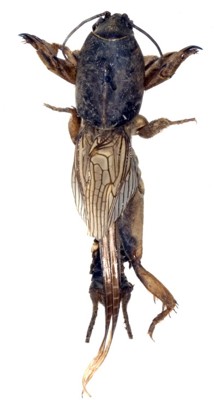Pests
Gryllotalpa unispina Sauss. - Single-spiked Mole Cricket
Systematic position.
Class Insecta, order Orthoptera, suborder Ensifera, superfamily Grylloidea, family Gryllotalpidae, genus Gryllotalpa.Biological group.
Polyphagous pest.Morphology and biology.
Body length is 38-41 mm. Head, pronotum (except sides), tergites of abdomen, sometimes spots on forefemora and tibiae, dorsal surface of hindfemora and part of tibiae are brown or yellow-brown; the rest integuments are yellow or brown-yellow. Pronotum is elongate-oval, 1.3-1.4 times longer than its maximal width. Forewings are 1.8 times longer than its maximal width, having thin, feebly pigmented transverse veins. Wings are projecting behind the end of abdomen, but the wings of brachypterous form are reaching only seventh abdominal tergite. Forelegs of digging type are short, enlarged, with strong dents. Upper inner part of hind tibiae has 2-3 spines with large interval between first and second spines. Epiphallus is comparatively long with arcuate-concave sides, strongly widening toward tip, and having more or less developed lateral lobes. Parameres do not reach the midlength of epiphallus. Variability is displayed in integument coloring, forewing venation, wing length, number and position of spines on hind tibiae, as well as extent of epiphallus lateral lobes development. The Mole Cricket digs a central vertical gallery 120 cm deep finishing in a horizontal site for overwintering adults; larvae winter in the vertical gallery at a depth of 70-80 cm. In spring females make a nest 6x6 cm in size at the depth of 10-20 cm and lays 300 to 500 tawny eggs by groups; each egg is about 4-5 mm in diameter. In 2 weeks the mobile gray larvae hatch, leaving the nest after the first molt. Larva length varies from 5-6 to 20-30 mm in six instars. The complete cycle of development lasts 1 to 2-3 years depending upon climatic conditions.Distribution.
Area includes territory of the Black Sea and Caspian Sea coasts, then Kazakhstan, Central Asia, Iran and Afghanistan to South China. In the territory of the former USSR, the Single-spiked Mole Cricket is found in Ukraine (the south of steppe zone, the Crimea), Georgia, Armenia, Azerbaijan, Kazakhstan, Uzbekistan, Turkmenistan, Kyrgyzstan, Tajikistan, in the south of Western Siberia.Ecology.
G. unispina is halophilic, inhabiting only saline soils along seacoasts and lakeshores, as well as salt marshes. It flies during evenings and nights, and floats well. In warm weather the insect burrows holes at the ground surface, while in winter the hole depth reaches 50-100 cm. Mass emergence after wintering is usually observed at 12-15°C. The Mole Crickets mate underground, then the female builds a nest. Egg-batch consists of 100-350 or more eggs. Embryonic development lasts 10-20 or more days. Normal egg development requires 100% humidity. Hatching larvae remain in their nest, guarded by the female for 2-3 weeks. Feeding and burrowing holes underground, the Mole Cricket gnaws through the roots of plants, eating tubers and rhizomes. It also feeds on many soil invertebrates including insects and earthworms. Natural enemies are birds (rooks, starlings, etc.), insectivorous mammals (shrews, moles), ants (destroying eggs), carabids (feeding on larvae), nematodes of the family Mermithidae, mites of the family Erythracidae. Fungal diseases may cause mass death of the pest during winters with thaws.Economic significance.
Mole Cricket is a wide polyphage. It damages cereals, legumes, perennial grasses, potato, almost all vegetables and melons and gourds, beet, sunflower, tobacco, hemp, flax, strawberry; it causes damage in hotbeds; in nurseries and young gardens it damages vines, fruit trees, and many other tree species. Shoots and young plants often perish after damage. Control measures include deep autumn plowing and inter-row treatments of soil, trapping in winter, and application of chemicals, poison baits, soil fumigation.Reference citations.
Ergashev N.E. 1976. Single-spiked Mole Cricket. Zashchita rastenii. 10: 40 (in Russian).Ergashev N.E. 1972. Biology of Single-spiked Mole Cricket Gryllotalpa unispina Sauss. In: Bei-Bienko G.Ya., ed. 8th International Entomological Congress. Moscow, 2-9 August 1968. Proc. V. 3. Leningrad: Nauka. p. 378 (in Russian).
Fedorova M.V., Zhantiev R.D., Gokhman V.E. 1991. Karyotypes of the Mole Crickets (Orthoptera, Gryllotalpidae) of the European part of the USSR and the Caucasus. Zoologicheskii zhurnal. 70(7): 43-50 (in Russian).
Gerasimov B.A. & Osnitskaya E.A. 1961. Mole cricket (Gryllotalpa gryllotalpa L.). In: Pests and diseases of vegetable cultures. Moscow: Sel.khozgiz, p. 380-382 (in Russian).
Gulyamova D.B. 1986. Nematodes of Mole Cricket (Gryllotalpa unispina) in Karakalpakiya. In: Uzbekskii biologicheskii zhurnal. Muzafarov A.M., ed. 5: 63-64 (in Russian).
Mishchenko L.L. 1972. Order Orthoptera. In: Kryzhanovskii O.L., Dantsig E.M., eds. Insects and mites are pests of crop. V. 1. Exopterygotes. Leningrad: Nauka, p. 49 (in Russian).
Shchegolev V.N. 1964. Mole Crickets. In: Entomology. Moscow: Vysshaya shkola, p. 86-87 (in Russian).
Zhantiev R.D. 1991. Mole Crickets (Orthoptera, Gryllotalpidae) from the European part of the USSR and Caucasus. Zoologicheskii zhurnal 70(6): 69-76 (in Russian).
Zhantiev R.D., Korsunovskaya O.S., Sorokin N.N., Chukanov V.S. 2003. Sound signals in Mole Crickets from Eastern Europe. Zoologicheskii zhurnal 82(11): 1339-1346 (in Russian).


